 |
||
|
||
| ||
Radio networks utilize no cables and can be quickly set up. Although most solutions based on the 802.11 standard can be successfully used in small offices, they are not suitable for long-distance data transmission especially if the receiver is not within the view. By the way, most such solutions may have security problems (if encryption is based on the internal methods only). That is why such systems hardly suit for service operators of wireless data transfer systems. Broadband wireless systems are getting more popular in this sector. Unfortunately, a single standard is not adopted yet. Although its development started in 1999, only separate editions of the IEEE 802.16 have been confirmed. Some of such broadband solutions were announced at the press conference held by Wi-LAN Inc (the world-wide manufacturer of such systems) and Diamond Communications on April 21 in Moscow. The company presented two base systems certified in Russia: Ultima3 and Libra 3000. Ultima3The Ultima3 series covers fixed broadband radio access systems in the range of 5.8 GHz. It's used for data channels and distributed radio networks. The range of 5725-5800 MHz was certified in Russia in April. The Ultima3 supports patented MC-DSSS (Multi-code Direct Sequence Spread Spectrum) wireless technology. At present, Ultima3 is available in three solutions:
It ensures the point-to-point links up to 25 km at 10 Mbit/s. The systems are equipped with integrated antennae. Extend your point-to-point networks to ranges up to 75 km depending on an external antenna type (2m dish aerials of the amplification of >34 dB). For radio networks of the cellular structure. One point provides broadband coverage inside a circle of the radius up to 16 km to 1000 Customer Premise Equipment units (CPE).  The picture above demonstrates simplicity of migration (modernization) of the cellular structure from one coverage area to 4, each segmented into 4 base stations. 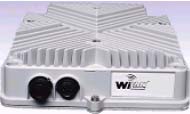
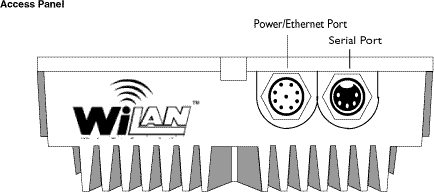 The Ultima3 has weatherproof design (-40 to +50 C) with an integrated or external antenna. Terminal equipment connects to the Ultima3 via 10/100Base-T interface with non-standard connectors which ensure tight connection. 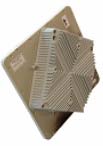 The Customer Premise Equipment (CPE) also has the weatherproof design and an integrated antenna of 23 dB. The effective bandwidth of the Ultima3 is 10 Mbit/s at the data rate of 12 Mbit/s in the point-to-point mode, and 8.5 Mbit/s in the multipoint mode. By the way, collisions are eliminated with the Polling with Dynamic Time Allocation (DTA). This mechanism allows flexibly managing the base station's bandwidth by setting Committed Information Rates (CIR) and Maximum Burst Rates (MBR) for separate subscribers. The support of polling and VLAN (802.1q) allows operators to provide QoS (quality of service) for every subscriber connected. Data transferred are protected by the physical-level scrumbling, with a unique encryption code for every client and a nonstandard modulation type (data can be received only by another Ultima3 system). However, the subscribers can be grouped on the physical-channel and VLAN levels. Libra 3000The Libra 3000 utilizes the Wide-Band Orthogonal Frequency Division Multiplexing Technology and works in the 3.5GHz range. Multiple low-speed channels located in a narrow range are used for OFDM data transfer. Data are transferred through a channel chosen adaptively depending on external noise. The same technology ensures high spectral effectiveness and tolerance to pickups which are caused by the signal multipass transmission. Another plus of the W-OFDM is that the devices can work out of the line-of-sight coverage using the signal reflected, which provides the maximum coverage area. The Libra 3000 systems are designed for distributed radio networks and for combination of segments of local networks into a single network. The Libra 3000 equipment utilizes the multi-point network topology. The Polling with Dynamic Time Allocation (DTA) is used for elimination of collisions. 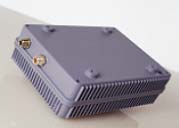
 The access point can be used only with external antennae. The system can be extended from one base station with an omnidirectional antenna to a 6-sector station with 60-degree antennae to provide the overall throughput of 96 Mbit. The Customer Premise Equipment (CPE) is produced in two versions - CPE with an externally mounted weatherproof antenna, and the same device without an integrated antenna but with a connector for an external one. 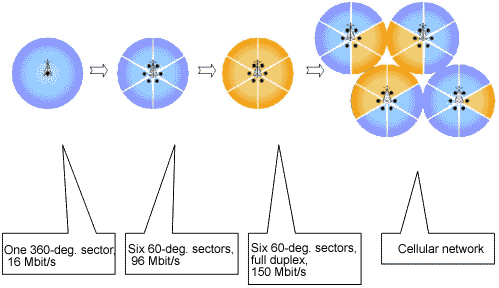 Like in case of the Ultima3, the strategy of development of a wireless network comes to gradual power increasing - from the base station with the omnidirectional antenna to the cellular network with the coverage area divided into the sectors. The company does not recommend using over 6 sectors. Full duplex (formally) can be obtained with two base stations for sector servicing. In this case the data rate in the sector grows 1.55 times (the rest is taken by the overheads). Out of two Libra 3000 models the Libra 3500 is the only model certified in Russia. It utilized the frequency range of 3500-356 MHz for the base station, and 3400-2460 MHz for the Customer Premise Equipment. The Libra 3000 supports allocation of the fixed bandwidth (CIR/MBR) for subscribers (i.e. Quality of Service) and VLAN (802.1q). The speed characteristics and the coverage area's radius of the Libra
3000 depend on the modulation method (it's defined when the equipment is
tuned) and the range width (at present there are models for 3.5 and 7 MHz).
According to the information at the Diamond's site, the coverage area's
radius indicated in the table can be reached at the channel availability
of 0.9995 (by the recommendation of ITU 530-8), amplification of the access
point's antenna of 14 dB, heights of the access point's antenna and customer's
one of 30 and 10 m respectively, and without extra losses in the track.
The distance ranges specified can be reached only within the line-of-sight
coverage. Subscribers located closer can work out of such area, but such
possibility is determined experimentally in each case.
You can see that the overheads in delivering a useful signal are low and run into 25% at most. It's much less than the 802.11b based technologies can ensure. Security of the Libra system is based on encryption by the Wi-LAN phase vector randomization method on the physical channel level. Decoding can be fulfilled only on the Libra equipment with the same vector settings. Besides, the W-OFDM modulation imposes limitation on the reception equipment. TestsDiamond tested the Libra 3000 and Ultima3 for their throughput. The results are close to the parameters specified by the manufacturer. The practical tests should be expected in the near future. P.S.I should stress it again that such systems are meant for service operators rather than for end-users. Although such systems are cheaper than the LMDS equipment, they are much dearer than solutions based on the 802.11 standards. And such systems will hardly become affordable for end-users in the near future.
Evgeniy Zaitsev (eightn@ixbt.com)
Write a comment below. No registration needed!
|
Platform · Video · Multimedia · Mobile · Other || About us & Privacy policy · Twitter · Facebook Copyright © Byrds Research & Publishing, Ltd., 1997–2011. All rights reserved. | |||||||||||||||||||||||||||||||||||||||||||||||||||||||||||||||